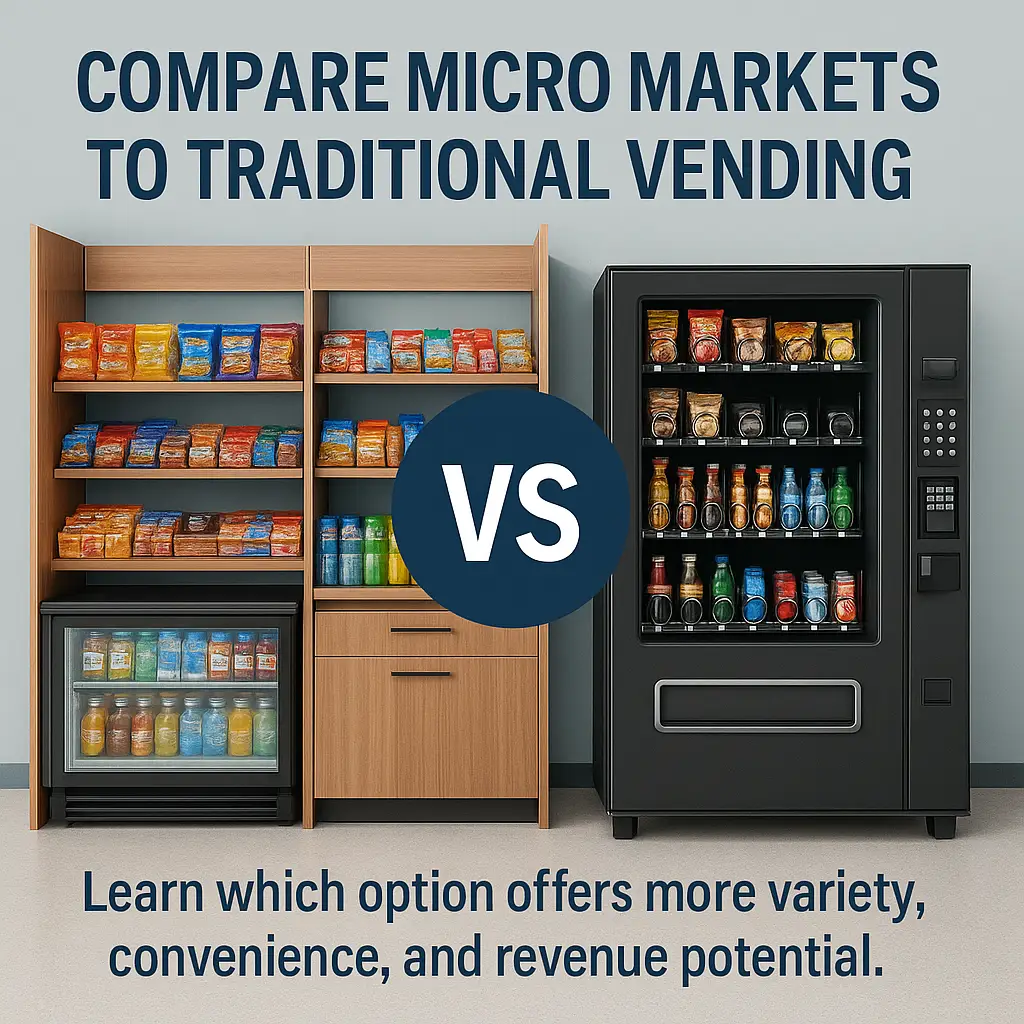Micro Market vs Vending Machines
Compare micro markets to traditional vending. Learn which option offers more variety, convenience, and revenue potential.
Back to Micro Market Services ResourcesCompare micro markets to traditional vending. Learn which option offers more variety, convenience, and revenue potential.
Back to Micro Market Services ResourcesMicro markets greatly expand product variety compared to vending machines, offering fresh meals, protein snacks, and more. Their open design makes browsing easier, with self-checkout kiosks allowing quick, contactless payment.
![]() Micro markets offer hundreds more product options than vending machines
Micro markets offer hundreds more product options than vending machines
![]() Open layouts and self-checkout increase user convenience and sales
Open layouts and self-checkout increase user convenience and sales
![]() Smart inventory tools reduce waste and restock downtime
Smart inventory tools reduce waste and restock downtime

Businesses increasingly face the decision between installing traditional vending machines or upgrading to micro markets. Both options offer unattended retail services, but they differ significantly in variety, layout, and potential revenue. Understanding these differences is key to selecting the right fit for your space and your users’ preferences.
Vending machines are compact and convenient, ideal for areas with limited space or smaller user bases. They dispense snacks and drinks automatically, generally offering a limited selection of prepackaged items. While vending machines are relatively easy to maintain, they come with some common frustrations: expired goods, mechanical failures, and restricted product variety.
Micro markets, on the other hand, resemble a self-service convenience store. They typically include open shelving, refrigerated coolers, and a self-checkout kiosk. Because of this layout, they can stock a much broader product range—fresh meals, salads, energy drinks, premium snacks, and even shelf-stable entrees. Customers can freely browse before purchasing, which encourages larger and more frequent purchases, often increasing location revenue.
Payment systems also set the two apart. While most traditional vending machines now accept contactless payment, micro markets go even further, often incorporating smart checkout kiosks and mobile app integration. Their advanced technology not only supports customer convenience but also aids operators with real-time inventory tracking and customizable product offerings.
Setup requirements vary by format. Vending machines require less space and infrastructure, while micro markets need room for shelving, coolers, and a checkout station. However, the potential for a better user experience and stronger sales often justifies the additional space for suitable locations such as offices, schools, or residential buildings.
Choosing between vending or micro markets depends on your goals. If variety, healthy options, smart tech, and higher revenue are priorities, micro markets are likely the better pick. If your space is small or traffic is low, traditional vending machines may be more practical.
For example, schools looking to expand student snack choices while staying compliant should consider reading our guide on student-focused vending programs. Additionally, administrators can benefit from our insights on earning parent and staff support for vending in educational settings.
If you're exploring vending options for your business, Vending Exchange can help simplify the process. Delivery, Installation and Equipment is provided at no cost to you - vendors provide the machines, keep them stocked, and handle all servicing. Whether you need a provider or full-service management, just fill out the form on this page to get started.
Micro markets offer open shelving and self-checkout kiosks, while vending machines dispense items automatically through a machine interface. Micro markets provide significantly more product variety.
Micro markets typically generate higher revenue due to greater product selection, premium pricing, and larger average transaction size.
Yes, micro markets require more room for shelving, coolers, and a checkout kiosk—making them ideal for medium to large spaces.
Yes, their open format allows for an expanded selection of healthy snacks and fresh food items not suitable for vending machines.
Micro markets typically use cashless and contactless payment systems like kiosks, mobile apps, and credit cards.
Micro markets require more frequent restocking and inventory oversight, but they also use smart systems to streamline this process.
Yes, micro markets often include refrigerated coolers for fresh meals, salads, sandwiches, and beverages.
Vending machines are more space-efficient, quicker to install, and ideal for lower traffic areas or tight spaces.
Yes, most modern vending machines and all micro markets support contactless payments through cards or mobile devices.
Micro markets offer real-time inventory and smart tracking tools, making restocking more intelligent and efficient compared to traditional vending.